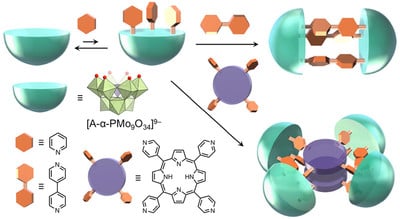Authors
Chifeng Li, Noritaka Mizuno, Kazuya Yamaguchi,* and Kosuke Suzuki*
Abstract
The development of novel systems for metal–organic architectures is an attractive research field because they are fascinating materials with unexplored functions. Lacunary polyoxometalates (POMs) offer structurally well-defined coordination sites with various coordination directions and numbers in addition to the designable properties; thus, lacunary POMs are ideal building blocks for inorganic–organic architectures. However, their utilization is currently limited by their low stability and difficulty in controlling the reactivity. Here, we report the successful self-assembly of anionic POM–organic architectures comprising multivacant lacunary POMs and pyridyl ligands. By introducing pyridine moieties to its vacant sites, the trivacant lacunary phosphomolybdate [A-α-PMo9O34]9– is significantly stabilized in organic solvents. Furthermore, the resultant structure can be utilized as a stable and reactive building block to synthesize a dimer pillared by 4,4′-bipyridyl and a tetramer bridged by two cofacial porphyrin ligands, which can intercalate aromatic molecules.

Journal of the American Chemical Society:https://pubs.acs.org/doi/10.1021/jacs.9b02541